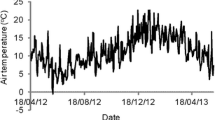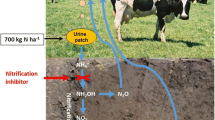Abstract
Purpose
Nitrous oxide emissions from pasture soils account for one third of total agricultural greenhouse gas emissions in New Zealand. The aim of this study was to determine nitrous oxide (N2O) emissions from animal urine patches under summer (with irrigation) and winter conditions as affected by dicyandiamide (DCD) in grazed grassland in New Zealand.
Materials and methods
Sixteen monolith lysimeters were collected from an established perennial ryegrass (Lolium perenne) and white clover (Trifolium repens) pasture on a Templeton fine sandy loam (Udic Ustochrept) located near Lincoln University on the Canterbury plains of New Zealand to study the N2O emissions from animal urine as affected by season and a nitrification inhibitor dicyandiamide. The experiment was conducted in the summer of 2008–2009 and the winter of 2009 with four treatments (control, control + DCD (10 kg ha−1), urine (1,000 kg N ha−1), urine + DCD) for both seasons. N2O fluxes from the pasture were measured in summer and winter.
Results and discussion
Results showed that the application of urine significantly increased N2O emissions and the application of nitrification inhibitor, DCD, to pasture soil was very effective in reducing N2O emissions both in summer and winter. Total N emissions from urine-N applied at 1,000 kg N ha−1 were 7.8 kg N2O–N ha−1 in the summer season and this was much lower than the 12.7 kg N2O–N ha−1 emitted during the winter season. The application of DCD reduced summer N2O–N emissions to 4.8 kg N2O–N ha−1 and winter N2O–N emissions to 3.9 kg N2O–N ha−1, representing 40% and 69% reductions in the summer and winter seasons, respectively.
Conclusions
The results demonstrate that N2O emissions from animal urine-N in grazed pastures were much higher in the winter season than in the summer season with irrigation and that DCD was more effective in reducing N2O emissions in the high-emitting winter season.


Similar content being viewed by others
References
Cameron KC, Smith NP, McLay CDA, Fraser PM, McPherson RJ, Harrison DF, Harbottle P (1992) Lysimeters without edge flow: an improved design and sampling procedure. Soil Sci Soc Am J 56:1625–1628
De Klein CAM, Eckard RJ (2008) Targeted technologies for nitrous oxide abatement from animal agriculture. Aust J Exp Agric 48:14–20
De Klein CAM, Smith LC, Monaghan RM (2006) Restricted autumn grazing to reduce nitrous oxide emissions from dairy pastures in Southland, New Zealand. Agric Ecosyst Environ 112:192–199
Di HJ, Cameron KC (2002a) Nitrate leaching in temperate agroecosystems: sources, factors and mitigating strategies. Nutr Cycl Agroecosyst 64:237–256
Di HJ, Cameron KC (2002b) The use of a nitrification inhibitor, dicyandiamide (DCD), to decrease nitrate leaching and nitrous oxide emissions in a simulated grazed and irrigated grassland. Soil Use Manag 18:395–403
Di HJ, Cameron KC (2003) Mitigation of nitrous oxide emissions in spray-irrigated grazed grassland by treating the soil with dicyandiamide, a nitrification inhibitor. Soil Use Manag 19:284–290
Di HJ, Cameron KC (2004) Effects of temperature and application rate of a nitrification inhibitor, dicyandiamide (DCD), on nitrification rate and microbial biomass in a grazed pasture soil. Aust J Soil Res 42:927–932
Di HJ, Cameron KC (2005) Reducing environmental impacts of agriculture by using a fine particle suspension nitrification inhibitor to decrease nitrate leaching from grazed pastures. Agric Ecosyst Environ 109:202–212
Di HJ, Cameron KC (2006) Nitrous oxide emissions from two dairy pasture soils as affected by different rates of a fine particle suspension nitrification inhibitor, dicyandiamide. Biol Fertil Soils 42:472–480
Di HJ, Cameron KC, Sherlock RR (2007) Comparison of the effectiveness of a nitrification inhibitor, dicyandiamide, in reducing nitrous oxide emissions in four different soils under different climatic and management conditions. Soil Use Manag 23:1–9
Di HJ, Cameron KC, Shen JP, Winefield CS, O’Callaghan M, Bowatte S, He JZ (2009) Nitrification driven by bacteria and not archaea in nitrogen rich grassland soils. Nature Geosci 2:621–624
Di HJ, Cameron KC, Sherlock RR, Shen JP, He JZ, Winefield CS (2010) Nitrous oxide emissions from grazed grassland as affected by a nitrification inhibitor, dicyandiamide, and relationships with ammonia oxidizing bacteria and archaea. J Soils Sediments. doi:10.1007/s11368-009-0174-x
Haynes RJ, Williams PH (1993) Nutrient cycling and soil fertility in the grazed pasture ecosystem. Adv Agron 49:119–199
Hutchinson GL, Mosier AR (1981) Improved soil cover method for field measurement of nitrous oxide fluxes. Soil Sci Soc Am J 45:311–316
IPCC 2007 Climate Change (2007) The Physical Science Basis. Contribution of Working Group I to the Fourth Assessment Report of the Intergovernmental Panel on Climate Change. Cambridge University Press,Cambridge, United Kingdom and New York, NY, USA
Jarvis SC, Scholefield D, Pain B (1995) Nitrogen cycling in grazing systems. In: Bacon PE (ed) Nitrogen fertilization in the environment. Marcel Dekker Inc., New York, pp 381–419
Kelliher FM, Ledgard SF, Clark H, Walcroft AS, Buchan M, Sherlock RR (2003) Revised nitrous oxide emissions from New Zealand agricultural soils: 1990–2001. Report prepared for the Ministry of Agriculture & Forestry. Landcare Research, Lincoln, New Zealand
Kelliher FM, Clough TJ, Clark H, Rys G, Sedcole JR (2008) The temperature dependence of dicyandiamide (DCD) degradation in soils: A data synthesis. Soil Biol Biochem 40:1878–1882
Luo J, Tillman RW, Ball PR (2000) Nitrogen loss through denitrification in a soil under pasture in New Zealand. Soil Biol Biochem 32:497–509
Luo J, Ledgard SF, Lindsey SB (2007) Nitrous oxide emissions from application of urea on New Zealand pasture. N Z J Agric Res 50:1
Luo J, Ledgard SF, de Klein CAM, Lindsey SB, Kear M (2008) Effects of dairy farming intensification on nitrous oxide emissions. Plant Soil 309:227–237
Luo J, de Klein CAM, Ledgard SF, Saggar S (2009) Management options to reduce nitrous oxide emissions from intensively grazed pastures: a review. Agric Ecosyst Environ 136:282–291
MfE (2008) New Zealand’s Greenhouse Gas Inventory 1990–2006: the National Inventory Report and Common Reporting Format, July 2007. Ministry for the Environment, Wellington, New Zealand. Also online: http://www.mfe.govt.nz/publications/climate/nz-greenhouse-gas-inventory-apr08/
Saggar S, Andrew RM, Tate KR, Hedley CB, Rodda NJ, Townsend JA (2004) Modelling nitrous oxide emissions from dairy-grazed pastures. Nutr Cycl Agroecosyst 68:243–255
Saggar S, Hedley CB, Giltrap DL, Lambie SM (2007) Measured and modelled estimates of nitrous oxide emission and methane consumption from a sheep-grazed pasture. Agric Ecosyst Environ 122:357–365
Silva RG, Cameron KC, Di HJ, Hendry T (1999) A lysimeter study of the impact of cow urine, dairy shed effluent and nitrogen fertilizer on drainage water quality. Aust J Soil Res 37:357–369
Velthof GL, Van Beusichem ML, Oenema O (1998) Mitigation of nitrous oxide emission from dairy farming systems. Environ Pollut 102:173–178
WMO (2003) Scientific Assessment of Ozone Depletion: 2002. Global Ozone Research and Monitoring Project Report No. 47, World Meteorological Organization, Geneva, 498 pp
Acknowledgments
We would like to thank the New Zealand Ministry of Agriculture and Fisheries (MAF) for providing the LEARN Fellowship; Carole Barlow, Steve Moore, Trevor Hendry, Neil Smith, Nigel Beale, Liang Qian, and Premaratne Manjula of Lincoln University for technical support.
Author information
Authors and Affiliations
Corresponding author
Additional information
Responsible editor: Caixian Tang
Rights and permissions
About this article
Cite this article
Qiu, W., Di, H.J., Cameron, K.C. et al. Nitrous oxide emissions from animal urine as affected by season and a nitrification inhibitor dicyandiamide. J Soils Sediments 10, 1229–1235 (2010). https://doi.org/10.1007/s11368-010-0242-2
Received:
Accepted:
Published:
Issue Date:
DOI: https://doi.org/10.1007/s11368-010-0242-2




